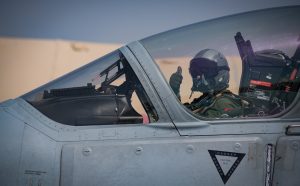After a nearly three-month wait, a group of U.S.-trained Afghan pilots and others who had flown to Tajikistan in a desperate mid-August scramble were finally transported to a third country for further processing.
On November 9, the U.S. Embassy in Tajikistan confirmed to RFE/RL that 191 Afghans, 143 of whom were pilots, were scheduled to finally depart Tajikistan. After what was reported as a “long delay,” the group left on a flight to the UAE, where the United States has been staging and processing Afghan evacuees since mid-August.
After landing at Bokhtar Airport in southern Tajikistan, the group was first taken to a student dormitory in the city. They were later moved to a sanatorium outside Dushanbe. The Afghans complained via smuggled cellphones of the conditions at the sanatorium. Tajik authorities reportedly confiscated the Afghans’ documents and phones, claiming the former were taken in order to verify their identities.
In early October, RFE/RL carried a detailed report on the group, which included pilots, air traffic controllers, engineers, and their families. The Afghans complained of cold and bad food. One of two female pilots in the group is pregnant, due in November, and complained that there were no female doctors at the sanatorium. She was soon after moved to a maternity hospital and was among those evacuated on November 9.
While a Tajik official on November 9 complained that the “U.S. bureaucratic machine” was responsible for the long delay, U.S. officials told Reuters that the Americans faced difficulty “securing Tajik authorization to access the pilots.”
The long limbo experienced by the Afghan pilots who landed in Tajikistan is arguably the product of the convergence of multiple, conflicting crises. The Tajik government is not known for the smoothness of its bureaucratic processes and the United States’ capacities were certainly strained by the massive effort that saw more than 120,000 people (U.S. citizens, Afghans, and others) evacuated from Kabul in a two-week period in August, followed by efforts to process Afghans for resettlement.
A much larger group of pilots and others who flew to Uzbekistan in mid-August were moved onward fairly swiftly, beginning in early September, following Taliban demands to the Uzbek government to return them to Afghanistan. Given the Tajik government’s lack of engagement with the Taliban, the Afghans who landed there were judged to be at lesser risk of being sent back.
In mid-September, The Diplomat spoke to a U.S.-based relative of one of the Afghan pilots. At that point, the timeline for their return was entirely unclear and communication limited. Tajik officials were occupied with other matters in September, including the country’s 30th independence anniversary and related activities in the first two weeks, and then in mid-September hosting two summits, for the Collective Security Treaty Organization (CSTO) and Shanghai Cooperation Organization (SCO).
Also in September U.S. evacuation efforts were paused across the board in response to concerns about measles, an extremely contagious disease caused by a virus that spreads via coughing and sneezing.
Together, these circumstances resulted in a long, frustrating, delay for the pilots.
On November 10, the Taliban government’s chief spokesman, Zabihullah Mujahid, again urged Afghan pilots to stay in the country and serve, reiterating a now-common mantra that they would be safe.
“My message is, there is no security problem for them (Afghan pilots) in Afghanistan, there is no plan of arresting them, national amnesty is announced,” Mujahid said, according to an Associated Press report. “It is regrettable that a number of pilots have gone, or they are going.”
Afghan pilots trained by the U.S. are considered at particular risk, and especially loathed by the Taliban given the devastating effect of airstrikes over the years. It’s not clear how many Afghan pilots remain in the country.
In late October, the Afghan pilots in Tajikistan told RFE/RL’s Tajik Service that the Taliban were attempting to force their return by pressuring their families who remain in Afghanistan.
The Taliban have reiterated their promise of amnesty for those who served the previous Western-backed government, but there is significant skepticism both about that pledge and the Taliban leadership’s ability to sustain it across the ranks of fighters.

































